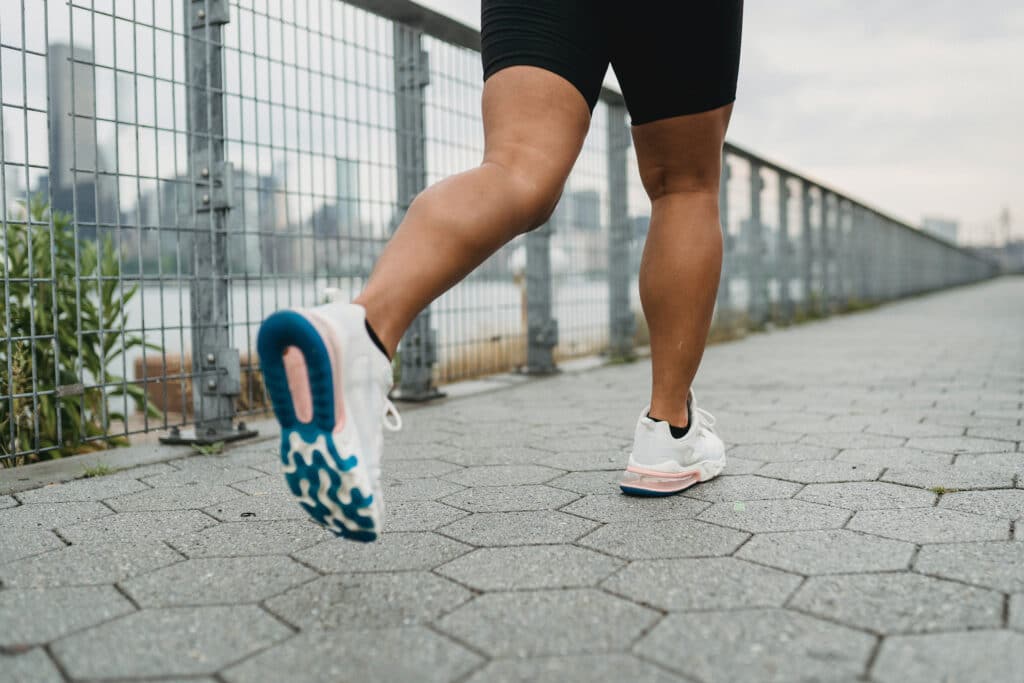


Running is a fantastic way to improve your cardiovascular health, relieve stress, and build endurance. But transitioning into a running routine can leave many beginners asking, “Will my legs ever get used to running?” The answer is yes – and this guide will provide helpful tips for easing into this new exercise regimen. Whether you are new to running or returning after a hiatus, your body will need time to adjust. So, let’s dive into the sore legs, beginner woes, and how to get back on track.
It’s normal for beginners to experience soreness in their legs when starting a running routine. This is because running uses muscles that may not be accustomed to regular use. Soreness can occur in various areas of the legs, including the calves, quads, hamstrings, and even the hips. This discomfort is a sign that your body is adapting to the new physical demands placed on it. The good news is that this soreness will decrease as you continue your running routine.
Through consistent practice, your body will become more efficient at running, leading to reduced leg soreness. This phenomenon is known as muscular adaptation. As your muscles grow stronger and accustomed to running, you’ll notice increased endurance and decreased discomfort, enabling you to run longer distances. Remember to listen to your body and take breaks when necessary, but don’t let initial soreness discourage you from achieving your goals. On average, it takes about 4 to 8 weeks for an individual to adjust to running, with the final timeframe influenced by factors such as current fitness level, age, and obesity. With a consistent and appropriate training regimen, your legs will acclimate to the demands of running.

If you’re new to running or returning after a break, here are a few helpful tips to ease the soreness and get your legs used to this new activity:
When embarking on a running journey, it’s crucial to remember the importance of starting slow. Avoid pushing yourself too hard too soon, as this can lead to injury and burnout. If you’re a beginner, consider incorporating a combination of walking and running into your routine. For instance, try running for one minute, followed by a one-minute walk, repeating this cycle for a total of eight repetitions. Allow your body to gradually acclimate to this new activity by initially opting for shorter, easier jogs and walks. As your body becomes more accustomed to running, you can gradually increase both the distance and pace. During the initial phase of training, it’s better to run too slow than too fast. Additionally, be sure to include at least one rest day between workouts.
It is crucial to increase both your distance and pace over time gradually. This practice allows your muscles, joints, and tendons to adapt and become accustomed to the repetitive motions of running. A good rule of thumb is to limit weekly mileage increases to no more than 10%. If you change your training plan too rapidly without giving your body a chance to adapt, you risk injury or overtraining, which will hinder your progress and ability to continue training.
Novice runners often make the mistake of starting with overly intense training regimens. Their eagerness to progress quickly often leads to overexertion due to a lack of knowledge. However, seeking a customised training plan or consulting with a coach can make a world of difference for those new to running. These resources can help establish realistic goals, offer guidance on proper form, and provide the necessary tools for steady and healthy progress. By following this approach, runners are less likely to push themselves too hard, which can result in giving up or sustaining injuries. For those interested, joining a running club or exploring our Coach the Run Beginners Training Plan could be highly beneficial.
Stretching your calves and quads is often overlooked by runners, but it is a simple yet crucial practice for developing leg strength. The objective is to enhance the mobility of your ankle and knee joints before starting your run, which helps prevent joint strain resulting from the repetitive nature of the activity. By prioritising stretching in your running routine, you not only increase your range of motion but also reduce the risk of injury and enhance overall performance. Focus on targeting the major muscle groups used during running, such as the hamstrings, quadriceps, and calves, to ensure optimal flexibility and minimize the risk of injury. Calves can be stretched by using a step, while quads can be stretched by standing or kneeling and holding your heel to your bottom. Remember to hold each stretch for 60 seconds to maximise its benefits.

Foam rollers, often seen as torture devices by many runners, actually play a crucial role in helping your legs go the extra mile. Incorporating foam rolling into your routine can bring significant benefits, such as reducing muscle soreness and enhancing recovery. By regularly using a foam roller, you can break down adhesions and scar tissue, resulting in lighter and more agile legs as you hit the pavement. Furthermore, the massage-like action of foam rolling helps increase blood flow, reduce muscle tension, and improve overall mobility, contributing to a reduction in inflammation. For targeted relief, focus on the outer hip area. Remember to roll slowly and pause for 15-20 seconds on the most sensitive spots.
Don’t overlook this simple yet crucial tip: proper footwear is essential for injury prevention and comfort while running. Invest in high-quality running shoes that cater to your specific foot type and gait. Reputable running stores now often offer on-site treadmills, where knowledgeable staff can observe your running style and recommend suitable shoes. Opt for moisture-wicking socks to prevent blisters and keep your feet feeling fresh. Additionally, consider using compression socks to reduce irritation to the calf fascia by minimising landing vibrations.
Increase your leg-strength training exercises
Incorporating strength training exercises into your workout routine can significantly reduce the risk of injury, enhance running form, and improve overall muscular health. It is crucial to prioritise the development of leg strength through regular gym sessions. Consider including exercises such as single-leg deadlifts, single-leg bridges, high step-ups, single-leg heel raises, and side planks to enhance leg resilience and support your running endeavors. Aim for high repetitions until reaching fatigue, with or without added weight. For optimal results, it is recommended to follow this program three to four times per week for a duration of six to eight weeks. This consistent effort will yield noticeable benefits.
Finally, rest and recovery should never be underestimated. It’s crucial to prioritise adequate sleep, incorporate rest days, and listen to your body. These practices allow your legs to heal and grow stronger after each run. Often, runners become fixated on mileage, thinking that more is always better. But that’s a misconception. Running puts significant stress on your body’s major joints, especially when pounding the streets. Therefore, it’s essential to learn the art of taking rest and focus on the quality of your training rather than the quantity. Distribute your training runs throughout the week, treat yourself to weekly sports massages, and opt for running tracks or trails instead of roads whenever possible. The forgiving surface will make a difference.
With patience, hard work, and mindful practices, your legs will indeed get used to running. Implementing the tips outlined in this guide should put you well on your way to achieving your running goals. Give our Coach the Run Beginners Training Plan a try, and watch as running becomes an enjoyable and natural part of your routine.
Ready for more of a challenge? Take a read of our 4 hour pace marathon blog.
Remember, running is a journey and not a race. So lace up those shoes, take it one step at a time, and watch as your legs become stronger and more accustomed to this fantastic form of exercise. Hit the trails and start enjoying the wonders of running!
Join our mailing list to stay up to date with the latest UK running events, training tips, and exclusive offers on running products. Rest assured, we value your privacy and would never dream of selling your address. Sign up now…
Share this article
For 2026, the London Marathon has changed its Good For Age (GFA) qualifying times, and...
How much did you pay attention to your sleep when you were running Mike? It...
Hi Mike, the 4-hour mark feels like both a mental and physical barrier. What strategies...
When it comes to running marathons, injury prevention is essential for any runner. Not only...
Well, yes and no. That is, I did it, and that I know lots of...
Can you start running at 50? Absolutely, and safely too. In this guide, we’ll explain...
We’re here to make sure you’re up-to-date with the latest running tips, events and product discounts – we’ve always got your back! Rest assured, we value your privacy and would never dream of selling your address.
BONUS: Sign up today and receive a FREE code for our Sub-4-Hour Marathon Plan